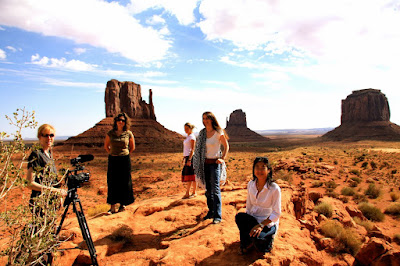
Caitlin Sislin, Women's Earth Alliance, North America Director
Where do you get your power? Does it emerge from the ground beneath your feet? Do you look to the sky or to the waters for it? Does it coalesce within your community? As power flows towards you, does it render others’ lives bleak while it brightens yours? Will your great grandchildren’s great grandchildren be fortunate enough to derive their power from the same places as you do?
These are the questions that our team of delegates -- women leaders from across the environmental and green energy advocacy spectrum -- investigated during our Fall 2010 Advocacy Delegation, Promoting Energy Justice on the Navajo Nation. During our five-day journey from Flagstaff, Arizona to Shiprock, New Mexico, our team met front-line leaders of the Dine’ movement for a just transition from fossil fuels to sustainability. These courageous women and men generously shared their stories, struggles and strategies with us, together describing a shared vision for an end to the U.S.’ reliance on dirty power derived from indigenous lands, and a turning towards the abundant solar, wind and non-polluting energy potential of tribal lands.

Our Dine’ colleagues and hosts spoke to us of the potential for healing and transformation inherent in this power shift. They modeled the efficacy of coordinated grassroots action to bring that vision to life. And they named the importance of broad-based coalitions to support the vision for ecological and economic justice for indigenous peoples.
How do we unplug from these injustices and desecrations, when so many of us unwittingly or unavoidably rely on fossil fuels to power our modern lifestyles? Bound, as so many of us currently are, to cheap electricity and an economic system that ceaselessly plunders and contaminates the most sacred places of the original peoples of this land, how do we engender the transformation so critically needed at this time in history? As allies to indigenous leaders working for environmental justice, it is incumbent upon us to ask hard questions of ourselves and of our communities: who and what suffers so that we can turn on the lights, and what will it take to find another way?
 Discovering the destruction is remarkably easy: anyone can follow the path of the gargantuan transmission lines crossing the Southwestern desert back to the coal mines, the power plants, the contaminated water tables, the birth defects and cancer clusters. But finding a new way is a more complex task that will require everyone’s participation. For some of us, it means employing our expertise at the federal level, demanding increasingly stringent air- and water-quality regulations, the overhaul of corrupt agencies, and the overturning of ill-advised permits to power plants and mineral extraction operations.
Discovering the destruction is remarkably easy: anyone can follow the path of the gargantuan transmission lines crossing the Southwestern desert back to the coal mines, the power plants, the contaminated water tables, the birth defects and cancer clusters. But finding a new way is a more complex task that will require everyone’s participation. For some of us, it means employing our expertise at the federal level, demanding increasingly stringent air- and water-quality regulations, the overhaul of corrupt agencies, and the overturning of ill-advised permits to power plants and mineral extraction operations.For others, it means organizing around state and local ballot propositions, working to build legislative bridges between economic development and environmental sustainability. For yet others, it means jumping into the trenches of business development, supporting the strategic planning, capitalization and implementation of far-seeing projects like utility-scale solar installations on reclaimed mine land on tribal reservations.
And for all of us, it means becoming ever more aware of the effect of each of our actions – even the most minute, like flipping a light-switch – has on the web of life.
Our dedicated Advocacy Delegation team learned that we have all the power we need – the power to say no to destruction, the power to say yes to an equitable, healthy future for all of us, and the power to act in alliance with the deeply-rooted vision for sustainability held by indigenous women and men throughout North America.


Brilliant.
ReplyDeleteO comments?What's up with that,community? What an increbly awesome post, Sistar Caitlin!!!
ReplyDelete